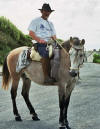
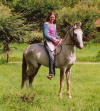

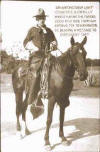
Edward "Tex" O'Reilly was an American soldier of fortune who is said to have fought in ten wars under many flags. Initially serving in the U.S. Army in the Spanish-American and Philippine-American Wars, as well as the Boxer Rebellion, he also fought in Shanghai, Venezuela, Honduras and Nicaragua. He saw combat alongside Pancho Villa in Mexico and with led the Spanish Foreign Legion in North Africa. O’Reilly was also a noted Long Rider and no stranger to hardship. So it comes as no surprise to learn that he volunteered to ride from San Antonio, Texas to Chicago, Illinois bearing a message from the Governor of Texas to President Taft. “I had a wonderful time on that 1,700 mile ride. When I reached Chicago I learned President Taft was at a baseball game. So I rode my horse onto the diamond and dashed up to him. The amazing thing was he recognized me, remembering me from the days when I commanded his bodyguard in the Philippines.” O’Reilly later became a reporter for the Associated Press and wrote a fascinating auto-biography entitled “Born to Raise Hell.”
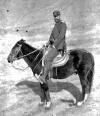
Ole Olufsen made two
mounted explorations of the Pamir Mountains in 1896 and 1898. He was
assisted by the Emir of Bokhara and travelled peacefully among the Kirghiz
and Tajiks residing in the remote valleys. Olufsen was interested in
documenting the high alpine lakes in the Pamirs. During his journey Olufsen
made a number of interesting cultural observations, including the Kirghiz
belief that a breed of mythical seahorses lived in these isolated lakes.
These strange horses supposedly emerged from beneath the waves at night,
whereupon they began grazing and breeding with the local horses who resided
on land. When his journey was concluded, the Danish Long Rider was honoured
by Czar Nicholas in St. Petersburg, on his way home to Copenhagen.
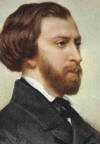
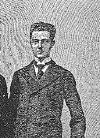
Prince Henri d'Orléans. An heir to the throne of France, a notorious duellist, a big game hunter, an acclaimed author, and handsome to boot, Prince Henri d'Orléans was a dashing French Long Rider whose ride across Asia in 1889 remains the stuff of legend.
Though born with an ancestral claim to the French crown, the dashing aristocrat embraced democracy in its place. Denied a role in the military because of his nobility, the Prince succumbed instead to the call to adventure by volunteering to accompany the rugged French Long Rider, Gabriel Bonvalot, on that explorer's journey from Paris to Hanoi, via the frozen wastes of Siberia, the burning Takla Makan desert and the forbidding Himalayan Mountains. The journey across Tibet subjected them to appalling conditions. While crossing 6,000 metre mountains, they endured temperatures as low as minus 40 degrees centigrade, and saw no human habitation for nine months.
They made an equestrian odd couple, the rough, good-natured, older Bonvalot and the twenty-five-year-old princely cub in search of an exciting quest. Yet together they overcame hardships and accomplished one of the greatest equestrian journeys in human history.
One interesting point about their journey has just been discovered. Upon leaving Tibet, the French Long Riders used a remote and carefully guarded route known as "The Little Tea Road" which led them into China. In a strange twist of fate, the modern equestrian traveller, Daniel Robinson, journeyed into Tibet in 2006 via a route known as The Teat Horse Trail.
Upon the completion of their record-making ride, Prince Henri and his mentor returned to Europe where they were both awarded various honours. Prince Henri was singled out for a Gold Medal by England's Royal Geographical Society.
Yet despite the acclaim, the Prince was soon involved in other explorations. This included hunting tigers in India, exploring Madascar, venturing deep inside Abyssinia and discovering the headwaters of the remove Irawaddy river. When he wasn't exploring, the Prince engaged in a swordfight with an Italian nobleman, Vittorio Emanuele the Count of Turin. Sadly, the suave Long Rider died as he had lived, while travelling. During a journey around the world, Prince Henri was stricken by illness and died soon afterwards in Saigon on August 9, 1901. He was thirty-four years old, and though there was talk that a statue was to be erected in his honour in Cochin, The Long Riders' Guild has been unable to confirm if this occurred.
Johannes Østrup was the brilliant Danish student whose journey through Egypt and the Ottoman Empire had important long term effects. During the years 1891-93 Østrup rode an Arabian stallion 4,500 kilometres through Egypt, Syria and Asia Minor, all the while he meticulously studied Islamic culture and language first-hand. Upon his return to Denmark, his adventurous journey was recounted in his excellent book Växlande Horisont. Yet his travels had other long term implications. After becoming Denmark's youngest Doctor of Philosophy, Østrup was able to decisively comment on the geography of Xenophon's book, "Anabasis". Then, having exchanged his saddle for the university lectern, Østrup devoted his life to the study of languages and literature. Like the Swedish Long Rider, Valdemar Langlet, Østrup investigated the idea of creating a universal human language in the hope that a common tongue would help break down national prejudices. His intense study of the Muslim world, resulted in Østrup being named as the professor of Islamic culture at Copenhagen University, where he introduced the study of Arabic dialects and Ottoman Turkish. Among his many books, Østrup translated the classic "A Thousand and One Nights" and wrote "The Encyclopaedia of Islam" and an acclaimed biography of the Prophet Muhammad (PBUH).

The Overland Westerners: George and Charlie Beck, Jay Ransom and Raymond Rayne - rode to all 48 state capitals in the USA. Their remarkable journey began in 1912, when the four riders embarked on a cross-country trip they hoped would bring them fortune and fame. It was called the ride of the century, a 20,000 mile odyssey through desert, mountain, and swamp that the four young horsemen dreamed would make them famous. Instead, they rode into oblivion.
They set off on the May 1, 1912 from the village of Shelton, Washington. Their first destination was Olympia, the nearby state capital. There they had their photograph taken with the governor and received an official document known as a “Certificate of Call” which confirmed their arrival at that city. For the next three years the Overland Westerners rode through all weathers, crossed every geographic challenge and survived terrible economic hardship in their quest to be the first persons in history to ride to all 48 American state capitals.
They reached Sacramento, their 48th and last state capital on May 24, 1915. They had been in the saddle for three years and one month, a record 1127 days of that time spent riding. They had gone through 17 horses on the 20,352 mile trip. During this time the men had spent just $9,000 between them.
After their photograph was taken with the governor of California, the Overland Westerners set out for the last stop, the Panama Pacific International Exposition in San Francisco. Arriving there on June 1, 1915, they expected to be greeted by the boisterous crowds, gathered there to celebrate the opening of the Panama Canal. They thought the people would great them as homecoming legends. Instead an Irish cop yelled at them to “get them hayburners off the street.” Little Sheba the belly-dancer was big news. Four saddle-sore heroes were not. They came expecting glory. They found only financial failure.
Within days their story and marvellous achievement was rapidly forgotten by an apathetic public more interested in the outbreak of World War One than four weary men and their footsore horses. George Beck’s three companions, tired, broke and broken-hearted, sold their horses and tack and rode the rails home to Washington. George stayed on in San Francisco trying to coax a story out of editors and authors. Jack London, among others, turned him down. With no hope and no pot of gold, George managed to pull off his last miracle. He saved his horse.
Pinto was the only mount who had managed to complete the entire gruelling trip. The tough little 15 hand, 900 pound Morab gelding had started the journey as the humble pack horse. But he soon left his pack saddle behind and become George’s equine soul-mate. Beck scraped together enough money to get him and the ever-loyal Pinto passage home on a tramp steamer. They arrived back in Puget Sound to no fanfare. Beck tried to put his recollections into a book but had no success.
“I wrote it sweet enough but it came
up sour,” he said.
That brief statement could have summarized his life and great adventure.
Beck, the man who had saddled his dream and rode it out, died one night dead
drunk, drowned in a six-inch deep roadside ditch. Soon after his master’s
death, Pinto was sent off to labour one last time, lugging a packsaddle once
again, through the thick, rainy depths of the Olympic National Forest. Pinto
was never heard of again.
After that all trace of the Overland Westerners soon disappeared.
In 1925 a former US Cavalry man, Frank Heath, set out to ride to the edge of all 48 states. After he completed his 11,000 mile journey, Heath wrote an important book entitled “Forty Million Hoofbeats.” He did not record encountering anyone who met or remembered Beck and his companions. It was not until 1998, when a detailed account of their journey was released, that the astonishing story of the Overland Westerners was rescued from oblivion.